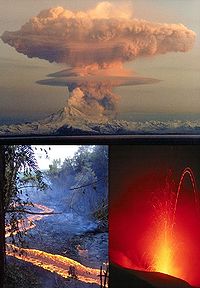
Photo from wikipedia
Abstract. Volcanic emissions are a source of halogens to the atmosphere. Rapid reactions convert the initially emitted hydrogen halides (HCl, HBr, HI) into reactive species e.g. BrO, Br2, BrCl, ClO,… Click to show full abstract
Abstract. Volcanic emissions are a source of halogens to the atmosphere. Rapid reactions convert the initially emitted hydrogen halides (HCl, HBr, HI) into reactive species e.g. BrO, Br2, BrCl, ClO, OClO and IO. The activation reaction mechanisms in the plume consume ozone (O3), which is entrained by in-mixed ambient air. In this study, we present observations of the oxidation of bromine, chlorine and iodine during the first 11 minutes after emission, investigating the plume of Santiago Crater of Masaya volcano in Nicaragua. Two field campaigns were conducted, in July 2016 and September 2016. The sum of the reactive species of the respective halogens were determined by gas diffusion denuder sampling followed by GC-MS analysis, while the total amounts of halogens and sulfur amounts were obtained by alkaline trap sampling with subsequent IC and ICP-MS measurements. Both ground and airborne sampling with an unmanned aerial vehicle (including a denuder sampler in combination with an electrochemical SO2 sensor) was performed at different distances from the crater rim. The in-situ measurements were accompanied by remote sensing observations (DOAS). For bromine, the reactive fraction increased from 0.20 ± 0.13 at the crater rim to 0.76 ± 0.26 at 2.8 km downwind, while chlorine showed an increase of the reactive fraction from (2.7 ± 0.7) × 10−4 to (11 ± 3) × 10−4 in the first 750 m. Additionally, a reactive iodine fraction of 0.3 at the crater rim and 0.9 at 2.8 km was measured. No significant increase in BrO / SO2 molar ratios was observed with the estimated age of the observed plume ranging from 1.4 min to 11.1 min. This study presents a comprehensive gas diffusion denuder data set on reactive halogen species and compares BrO / SO2 ratios with the sum of all reactive Br species. With the observed field data, a chemistry box model (CAABA/MECCA) enabled the reproduction of the observed progression of the reactive bromine to total bromine ratio. An observed contribution of BrO to the reactive bromine fraction of about 10 % was reproduced in the first minutes of the model run. The model results emphasize the importance of ozone entrainment into the plume for the reproduction of the measured reactive bromine formation and the dependence on the availability of HXOY and NOX.
Journal Title: Atmospheric Chemistry and Physics
Year Published: 2019
Link to full text (if available)
Share on Social Media: Sign Up to like & get
recommendations!